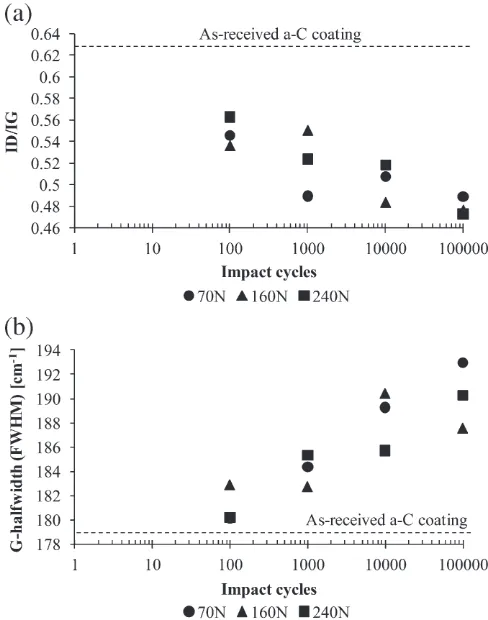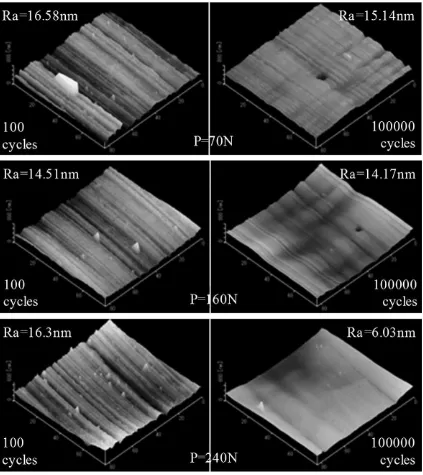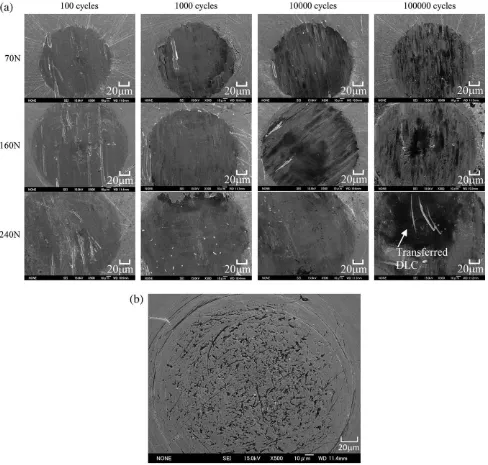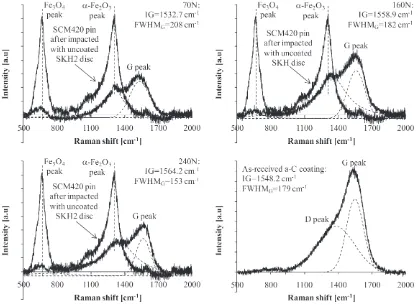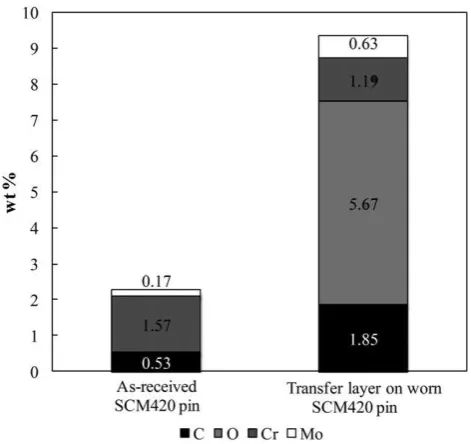Mohd Fadzli Bin Abdollah
⁎
, Yuto Yamaguchi
, Tsuyoshi Akao
, Naruhiko Inayoshi
, Noritsugu Umehara
,
Takayuki Tokoroyama
aaAdvanced Materials and Manufacturing Laboratory, Department of Mechanical Science and Engineering, Graduate School of Engineering, Nagoya University, Furo-cho, Chikusa-ku,
Nagoya, 464-8603, Japan
bMaterials Engineering R&D Department, DENSO Corporation, 1-1 Showa-cho, Kariya-shi, Aichi, 448-8661, Japan
a b s t r a c t
a r t i c l e
i n f o
Article history:
Received 25 May 2010
Accepted in revised form 19 July 2010 Available online 24 July 2010
Keywords:
Impact test
Raman scattering spectroscopy a-C coating
The phase transformation of hydrogen-free amorphous carbon (a-C) coating on tungsten high speed steel (SKH2) substrates under repetitive impact testing has been studied. The a-C coated disc was impacted by the chromium molybdenum steel (SCM420) pin at several different impact loads and impact cycles (up to 100,000) under lubricated conditions. The results show that the sp3fractions of impacted a-C coating obtained from the surface of impact craters are significantly increased with impact cycles due to decreasing ID/IG ratio. This means that the amorphization of a-C coating also increased after several impact cycles. As for the full-width at half maximum (FWHM) of G peak characterization, it is shown that the hardness of impacted a-C coating is higher than the as-received. From the observation of surface roughness using atomic force microscopy (AFM), it is supposed that increasing sp3fractions and the hardness of the impacted a-C coating during impact correlate to the reduction of surface roughness. In addition, the tribochemical reaction to the environment during impact occurred at the mating material, where the transfer layer adhered, as well as in the wear debris. This is due to the oxidation of ferrum (Fe) to magnetite (Fe3O4) and hematite (α-Fe2O3) phases with predominant peak at about 680 cm−1and 1317 cm−1, respectively. The formation of Fe3O4andα-Fe2O3phases was revealed from Raman spectroscopy and the existence of oxide elements was verified by energy dispersive X-ray spectroscopic (EDS) analysis. Increasing the G peak position, together with a concomitant decrease of their width, it is believed that the structural transformation from sp3to sp2is taking place within the wear debris and leads to the graphitization process at a higher contact pressure. It was suggested that the high contact pressure is not just only corresponding to the applied normal impact load, but it is also exerted by an oil lubricant during impact. A high contact pressure can significantly reduce the graphitization temperature and substantially accelerate the graphitization process. However, a significant phase transformation of the transfer layer on the SCM420 pin does not intensely occur because it is mainly coming from the surface layer of the impacted a-C coating, where the sp3content increases and no wear debris is observed inside it.
© 2010 Elsevier B.V. All rights reserved.
1. Introduction
Hydrogen-free amorphous carbon (a-C), commonly known as diamond-like carbon (DLC) has attracted great attention for many applications due to its tremendous properties, such as high hardness, thermal stability, low friction coefficient and good chemical inertness. Furthermore, the a-Cfilm showed an excellent wear resistance in dry, water- and oil-lubricated conditions [1]. The a-C is a disordered mixture of carbon atoms with sp2and sp3hybridizations[2]. The sp3
hybrids confer diamond-like properties like high hardness, high density, chemical inertness, etc., while sp2 hybrids control the
electronic and optical properties because theπstates lie closest to the Fermi level[3].
The phase transformation of DLC due to sliding has been performed extensively for a decade[4–10]. However, there is still a lack of information about how the structure will change by repetitive impacts.
J.X. Liao et al.[6]reported that as the number of the sliding cycles or the load is increasing, the tribological properties decrease due to the graphitization of DLCfilms within a wear track. Y. Liu et al.[7]
showed with evidence that the transfer layer contained a fine distribution of graphite nano-particles in a distorted diamond-like structure. Besides, a graphitization process took place within the wear track region of the coatings probably due to thermal and strain effects from the repeated friction. A year later, Y. Liu and E.I. Meletis[8]said that the transformation of DLC to graphite-like may also be facilitated by shear stresses existing in the surface layer. However, Z.F. Zhou et al. ⁎Corresponding author. Tel.: +81 90 3967 5987; fax: +81 52 789 2788.
E-mail address:[email protected](M.F.B. Abdollah).
[9] suggested that the structural transformation of DLC coatings within the wear tracks was mainly due to the formation of a compact wear debris layer rather than a frictional heating effect. In addition, according to J.C. Sanchez-Lopez et al. [10], evidence of extended graphite layer formation was not observed in the transferfilm of DLC after friction test.
In this study, some other degradation also can exist on the a-C coating during repetitive impacts if the normal impact load is high enough, such as the propagation of cracks inside the impact craters and may result in the occurrence of cohesive failure. Moreover, no adhesive failures of the a-C coating are observed. However, the discussion about this degradation is beyond the scope of this paper. The objective of this paper is to discuss the changes in the structure of the a-C coating by applying different normal impact loads under repetitive impacts. The structure of the a-C coating is studied by means of Raman spectroscopy, EDS, AFM andfield emission scanning electron microscopy (FE-SEM).
2. Experimental
The disc specimens were coated with a-C by a physical vapour deposition (PVD) method. The measured hardness and thickness of the coating are approximately 25.13 GPa and 2.97μm, respectively. The SKH2 disc was used as a substrate. The impact test was performed using a self-developed impact tester.
The impact test rig, as shown inFig. 1, consisted of a load detector together with a cam that was designed to impact a-C coated disc with a SCM420 pin, with a radius of 1 mm under numerous impacts. The disc was repetitively impacted with a 90° inclination at room temperature. Kerosene was used as a lubricant. Prior to the impact test, both disc and pin were cleaned using acetone in an ultrasonic bath. The load was applied to the disc specimen via a spring system and was observed by the load detector. In this experiment, the frequency of the impacts was selected at 10 Hz. The dimensions of both disc and pin are shown inFig. 2.
The bonding structures of the wear debris and impact crater surfaces of the a-C coated disc, as well as the transfer layer on the pin, were studied using Raman spectroscopy in addition to EDS, AFM and FE-SEM observations. The Raman spectra were measured at room
temperature and were acquired over the range of 500–2000 cm−1at
1.1 cm−1resolution.
3. Results and discussion
Raman spectroscopy is the best way to obtain the detailed bonding structures of the DLCfilms[10]. The Raman spectra shown inFig. 3, which were taken from the surface layer of the impact craters, exhibit Fig. 1.Schematic illustration of a repeated impact tester.
Fig. 2.Dimensions of the a-C coated disc and SCM420 pin.
Fig. 3.Raman spectra of the as-received a-C coated disc and after impacted at 100,000 impact cycles under different impact loads.
a broad asymmetric peak in the range 1400–1700 cm−1and centred
at approximately 1550 cm−1. This con
firms that the coatings are amorphous carbon as reported by other researcher[11]. The G peak intensity is gradually increased, when compared to the as-received, after repetitively impacted at several impact loads. This implies that the amorphization is increased.
In order to obtain quantitative information about the sp3content
in the coatings, Raman spectra are considered a combination of D and G peaks by the Gaussian curves. The carbon peak is characterized by a large G peak close to 1550 cm−1with a broad peak shoulder close to
1370 cm−1. In the case of the amorphous carbon,“G”does not just
mean graphite. The G mode arises from the stretching of any pair of sp2sites, whether in rings or chains. The D mode is the breathing
mode of sp2sites in rings not chains[12]. The atomic bond structure of
the coatings is characterized by the intensity ratio (ID/IG) and FWHM values.
Some investigators have reported that the sp3 content can be
estimated from the variation of the ID/IG ratio with the sp3fractions
[13–15]. A smaller value of the ID/IG ratio will correspond to higher sp3content and amorphization.
Further analysis of the structural changes in the impacted a-C coating with impact cycles, is summarized inFig. 4. Based on the graph's trend, the ID/IG ratio decreases with the increasing number of impact cycles, accompanied by a widening of FWHM for the G peak, which correlates well to a higher sp3content with the increase of
amorphization. . This also suggests that the mechanical impact will destroy the larger resulting sp2clusters, which may be reduced in
their organization in the larger stacks of sp2dense planes, therefore,
no longer show any breathing modes.
Due to the difficulty in analyzing the hardness of the impact craters of the a-C coated discs by using a typical measurement, the Raman spectrum can provide this information. According to M.A. Tamor and W.C. Vassell[11], the hardness of amorphous carbonfilms increases with an increasing FWHM of the G-line. In addition, the hardness of thefilms is dependent on the sp3/sp2ratios of the carbon bonding and
From the graph inFig. 4(a) and (b), it clearly shows that the hardness of the impacted a-C coating also increases with the impact cycles and is pronouncedly harder than that of the as-received.
The increase in sp3content and hardness can be correlated to the
reduction of surface roughness[16,17]. This is in accordance with this study, where the surface of the impact craters is also smoother at the large impact cycles as shown inFig. 5. The observation is taken from the centre of the impact craters after 100 and 100,000 impact cycles, for each normal impact load. The rougher the surface, the more energy that has been dissipated during the plastic deformation and the more significant the indentation size effect (ISE) will be. This can be a cause of random scattering in hardness values, and their consequential decrease.
Fig. 6(a) shows the worn SCM420 pins examined from the FE-SEM micrographs after numerous impacts under different normal impact loads. The FE-SEM examination of wear scars revealed the transfer of material from the a-C coating surface to the mating SCM420 pin. Even after cleaning the pins ultrasonically in acetone to remove the loose particles and excess oil distributed on its surface, it was observed
that an adherent layer still existed, as indicated by the dark contrasting material in the FE-SEM micrographs. The micrograph of the as-received SCM420 pin is shown inFig. 6(b) for comparison. The black areas show a transfer layer and verification by EDS analysis as shown inFig. 10, where the elemental composition of the carbon element (C) is slightly increased compared to the as-received.
The Raman spectra of the transfer layer at different impact cycles under 240 N of normal impact load are summarized inFig. 7. In the case of the continuous presence of oil lubricant, the generated debris have been combined to oil and removed progressively by its evacuation outside the impact craters, hence, no wear debris is observed inside it. Therefore, the Raman spectra of wear debris were only obtained from the debris on the edge of the impact craters as shown inFig. 8. The FE-SEM micrograph of the wear debris is shown in
Fig. 9.
Also noticeable in the Raman spectra of both transfer layer and wear debris is an additional peak at approximately 680 cm−1. The
environments [10,11]. However, a sharp peak at approximately 1317 cm−1of the transfer layer and wear debris, is believed not to
have come from the disordered graphite (D peak). This is because these two predominant peaks also appeared when the uncoated SKH2 disc, was impacted by the SCM420 pin after several impact cycles. From Figs. 8 and 9, it is clearly indicated that these peaks are corresponding to the Fe3O4 and α-Fe2O3 phases, as described by
Lübbe, M. et al.[18].
Firstly, only Fe3O4is formed at low impact cycles and not so much
of the a-C phase was detected. However, after several impact cycles,
pin after 100,000 impact cycles under 240 N and compared with as-received is shown inFig. 10. The results show that the elemental composition of an oxide element (O) exists in the transfer layer. This is consistent with the Raman analysis, as shown inFig. 7.
A reasonablefit of the data for the Raman spectra of the transfer layer and wear debris could not be obtained using a single Gaussian line shape, and it was necessary to include in thefit a second and third Lorentzian centred at about 680 cm−1and 1317 cm−1, respectively.
However, the broad peak at about 1350 cm−1, which is probably due
to the disordered graphite (D peak), overlapped with theα-Fe2O3
peak at 1317 cm−1. Thus, the D peak is not clearly visible inFigs. 7 and 8. The ratio intensity of theα-Fe2O3peak (namely F peak) to the
G peak (IF/IG) of the wear debris under normal impact loads of 70 N, 160 N and 240 N is about 0.78, 0.88, and 0.92, respectively. This implies that the amount of the disordered graphite phase (D peak) is slightly increased.
It is proven as shown in the Raman spectra taken from the wear debris that the G peak has shifted to a higher frequency compared to as-received. It begins at a 160 N normal impact load. Therefore, it means that the sp2 bonding fraction increases, partial tetrahedral
bonds have been broken and have transformed to trigonal bonds[19]. Fig. 7.Raman spectra of the transfer layer on the worn SCM420 pin under different
impact cycles at a normal impact load of 240 N.
With the increasing of the normal impact load, the decrease in the FWHM of the G peak indicated the removal of a bond angle disorder and the increasing dominance crystallites[19]. From the analysis above, the sp2coordinated carbon becomes gradually dominant with
the increasing normal impact load and causes phase transformation from sp3to sp2, which would induce graphitization.
Sufficient temperature rise can promote the transformation of the thermodynamically meta-stable bonding structure (sp3) into the
more stable graphite-like structure (sp2). Experimental observations
show that during numerous impacts, a transfer layer forms on the worn pin surface. Because the transfer layer is mainly composed from the a-C coating, the tribological contact is modified from that of SCM420/a-C to a-C/a-C and significant temperature may result at the contact due to the low thermal conductivity of DLC. In addition, a graphitization threshold of the a-Cfilms was reached at 300 °C[20]. However, Z.F. Zhou et al.[9]and T. Haque et al.[21]have stated that graphitization temperature decreases when contact pressure increases. The applied normal impact loads were selected to be 70 N, 160 N and 240 N, creating initial Hertzian maximum contact pressures of 7.7, 10.1 and 11.5 Gpa, respectively. The contact pressure exerted by the counter body on the a-C coating is not just
only corresponding to the applied normal impact load. A high contact pressure may also be developed by the presence of oil lubricant on the contact surface of the a-C coating. It was shown both theoretically and experimentally by H. Christensen [22] that the maximum contact pressure was significantly larger than the corresponding ones produced under Hertzian, dry contact impacts. A small increase in load will produce a large increase in maximum pressure. For this reason, it seems that graphitization can occur at a high contact pressure due to low graphitization temperature during impact.
As mentioned earlier, the transfer layer mainly comes from the surface layer of the impacted a-C coating, where the sp3 content
increases. In addition, the wear debris, which has transformed from the sp3 to sp2 phase, is accumulated with oil and removed
progressively by its evacuation outside the impact craters. Conse-quently, the phase transformation of the transfer layer does not occur in depth as in the wear debris. However, fromFig. 7, a small shift of the G peak and a widening of its FWHM after 100,000 impact cycles at the normal impact load of 240 N suggest a high increase in temperature, while the size of the larger sp2 clusters is reduced due to the
mechanical crush of the larger sp2clusters.
4. Conclusions
From the Raman spectrum, the surface layer of the impacted a-C coating tends to have higher sp3fractions and is harder after several
impact cycles. Furthermore, the mechanical impact may destroy and reduce the size of larger sp2clusters. The observation of surface roughness
can be correlated to the increase of the sp3content and hardness in the
surface layer of the impact craters. The surface roughness of impact craters observed from the AFM decreases after several impact cycles.
Other features observed in the Raman spectra of the transfer layer and wear debris can be attributed to the formation of ferrum oxides by tribochemical reaction with the environment after several impact cycles. These peaks approximately centred at 680 cm−1and 1317 cm−1and
evidently came from the Fe3O4andα-Fe2O3phases, respectively.
As the normal impact load and impact cycles are increasing, the G peak of the Raman spectra, together with the narrowing of its peak width as shown in the wear debris, is shifting towards higher frequencies,. This suggests an increasing order and an enlargement of the sp2cluster. These structural modi
fications are induced during the impact test, causing a transformation of the sp3sites into sp2
sites and these are closely related with the graphitization process. The use of lubricant during the impact contributes to the higher contact pressure on the a-C coating. Thus it is therefore apparent that the high contact pressure is not only corresponding to the applied normal impact load, but also exerted by a lubricant on the a-C coating. Besides, the high contact pressure can reduce the graphitization temperature and substantially accelerate the graphitization process.
Although, the phase transformation of the transfer layer does not much occur as in the wear debris since it is mainly coming from the surface layer of the impacted a-C coating, where the sp3 content
increases and no wear debris is observed inside it.
Acknowledgement
The author, Mohd Fadzli Bin Abdollah gratefully acknowledges the scholarship from Universiti Teknikal Malaysia Melaka (UTeM) for his Doctoral study.
References
[1] K. Holmberg, H. Ronkainen, A. Matthews, Ceram. Int. 26 (2000) 787. [2] J. Robertson, Mater. Sci. Eng., R. 37 (2002) 129.
[3] J. Robertson, Phys. Rev. Lett. 68 (1992) 220.
[4] D. Sheeja, B.K. Tay, S.P. Lau, X. Shi, X. Ding, Surf. Coat. Technol. 132 (2000) 228. [5] S.J. Park, K.R. Lee, D.H. Ko, Diam. Relat. Mater. 14 (2005) 1291.
[6] J.X. Liao, L.F. Xia, M.R. Sun, W.M. Liu, T. Xu, Q.J. Xue, Surf. Coat. Technol. 183 (2000) 157.
Fig. 9.FE-SEM micrograph of the wear debris taken from the edge of impact craters. The top left micrograph is an impact crater.
